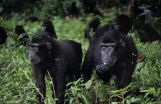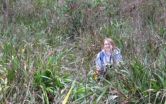(Press-News.org) Since at least the 1970s, the population of critically endangered Sulawesi black macaques living in an Indonesian nature reserve has been dropping. But a new study by researchers at the University of Washington and in Indonesia shows that the population has stabilized over the past decade.
The findings, published in the January issue of the American Journal of Primatology, are from the longest ongoing survey of Macaca nigra and are among the first evidence that the monkeys may be in better shape.
"Fifteen years ago it looked like this macaque population would continue its decline and eventually disappear," said Randall Kyes, lead author and UW research professor of psychology. This study "doesn't mean that everything is fine now and that we no longer need to worry about the fate of these animals, but it is good news compared with what we've seen over the past 30-plus years in this reserve."
Since 1997, Kyes and his Indonesian colleagues have conducted conservation-related studies of the black macaques at the Tangkoko Nature Reserve in North Sulawesi, Indonesia – an area known for its biodiversity, which attracts flocks of tourists each year. He and his team began the newly published population survey in 1999 and collected data through 2011.
Searching a specified section of the forest, the researchers took two daily counts during a two- to three-week survey period each year of the study. They only recorded numbers of black macaques they saw, though they would often hear many others.
The number of groups of macaques per square kilometer (0.40 of a square mile) increased from 3.6 in 1999 to 3.9 in 2005 and to 4.3 in 2011, the research team found. They observed a similar gradual climb in numbers of individuals per square kilometer: 32.4 in 1999, 53.8 in 2005 and 61.5 in 2011.
By these counts, the population size has returned to the level of nearly 20 years ago: a 1994 study reported 3.9 groups and 68.7 individuals per square kilometer. In contrast, a study in 1978, when scientists first began documenting the population's status, showed 10 groups and 300 individuals per square kilometer.
"We've found that the progressive decline has slowed," Kyes said. "Somewhere over the last 10 years the trend has started to turn. We're seeing the population in the balance now, but without the sustained efforts by local and international groups working in the reserve and the support and involvement of the local people, the macaques will likely face further decline."
Hunting and habitat loss are the chief culprits in the black macaque population's waning in recent decades. In North Sulawesi culture, black macaques are considered a food for special occasions, similar to a Thanksgiving turkey for people in the United States and Canada.
Though they did not examine this in their new study, the researchers' outreach education efforts for children who live near the Tangkoko Nature Reserve may be helping to decrease illegal hunting and trapping of the animals. The researchers also hold an annual field course in conservation biology and global health for local university students and the community.
"We focus on the importance of the human-environment interface and the close relationship between environmental health and human health," Kyes said. "We also emphasize how the black macaques support the local economy, by way of all the tourists who come to the nature reserve to see them."
He said that outreach to children is particularly helpful. "We don't chastise them for eating monkeys, but we do explain that there might not be many left in the future. We encourage them to ask their parents if there's something else they can eat."
INFORMATION:
Co-authors in Indonesia are Entang Iskandar of Bogor Agricultural University's Primate Research Center; and Jane Onibala, Umar Paputungan and Sylvia Laatung of Sam Ratulangi University. Co-author Falk Huettmann is from the University of Alaska-Fairbanks.
The study was funded by the Woodland Park Zoo in Seattle, One Earth Institute in Seattle, the International Primatological Society and the National Institutes of Health.
For more information, contact:
Kyes
206-619-5765
206-685-7159
rkyes@uw.edu
Research paper: http://onlinelibrary.wiley.com/doi/10.1002/ajp.22088/abstract
Better outlook for dwindling black macaque population in Indonesia
2013-01-23
ELSE PRESS RELEASES FROM THIS DATE:
Treatment targeting PI3K may delay resistance to anti-HER2 therapy in breast cancer patients
2013-01-23
PHILADELPHIA — Patients with HER2-positive breast cancer being treated with anti-HER2 therapy may be able to prevent or delay resistance to the therapy with the addition of a phosphatidylinositol-3 kinase inhibitor to their treatment regimens.
The data, published in Cancer Research, a journal of the American Association for Cancer Research, indicated that failure of the anti-HER2 antibody trastuzumab to block HER2 from activating the phosphatidylinositol-3 kinase (PI3K) signaling pathway can lead to resistance to treatment. Therefore, dual simultaneous inhibition of ...
Global plant diversity hinges on local battles against invasive species
2013-01-23
In Missouri forests, dense thickets of invasive honeysuckle decrease the light available to other plants, hog the attention of pollinators and offer nutrient-stingy berries to migrating birds. They also release toxins that decrease the germination of nearby native plants. Why, then, do studies of invasive species come to different conclusions about their effects and lead some organizations to suggest we accept their presence?
Biologists Kristin Powell, Tiffany Knight and Jon Chase of Washington University in St. Louis have found an answer.
Most studies of the effects ...
More efficient way to make popular prescription medication
2013-01-23
In a demonstration of the power of green chemistry, scientists are reporting development of a new and more efficient process for making one of the most costly and widely used medications for severe mental illness. Described in a report in the journal ACS Sustainable Chemistry & Engineering, it produces larger amounts of the medication than the existing commercial process while reducing the use of solvents and other potentially toxic substances.
Vijayavitthal T. Mathad and colleagues point out that paliperidone, marketed under the brand name Invega, is one of a new generation ...
Caloric restriction has a protective effect on chromosomes
2013-01-23
One of the indicators of a cell's health is the state of its DNA and containers—the chromosomes—so when these fuse together or suffer anomalies, they can become the source of illnesses like cancer and/or ageing processes.
According to a study carried out by a team led by María Blasco, the director of the Spanish National Cancer Research Centre (CNIO) and head of the Telomeres and Telomerase Group, a sustained lowering of food intake over time results in an increase of telomere length—the ends of chromosomes—in adult mice, which has a protective effect on the DNA and genetic ...
Products That Make a Difference: Discover MaxiAids' 2013/14 Catalog
2013-01-23
MaxiAids Products for Independent Living (www.MaxiAids.com) has released their 2013/14 Catalog. Commonly accepted as the 'Reference Guide of the Industry,' the MaxiAids Catalog contains the largest available assortment of items that support active, healthy and independent lives.
The most viewed catalog in the industry, it has thousands of budget-friendly assistive items for all age groups, no matter what their special need is. See more clearly with magnified, talking or large print daily living items such as talking watches and large numbered clocks! Never oversleep ...
Lower drinking ages can have an impact on later drinking patterns
2013-01-23
Lower minimum legal drinking age (MLDA) laws have been associated with short-term effects such as a greater number of traffic fatalities and teen suicides. A new study has investigated the long-term and persistent linkages between permissive MLDA laws and specific drinking behaviors such as average alcohol consumption, frequency of drinking, patterns of binge drinking, and moderate drinking. Findings support an association with problematic drinking behaviors that persist into later adulthood, such as more frequent binge episodes.
Results will be published in the March ...
Binge drinking can dramatically amplify damage to the liver
2013-01-23
Alcoholic liver disease (ALD) is characterized by a fatty liver, hepatitis, fibrosis, and cirrhosis. Binge drinking is on the rise worldwide, and is particularly common in the U.S. A review of studies addressing the effects of binge drinking on the liver underscores the complex interactions among various immune, signaling pathways, epigenetic, and metabolic responses of the liver to binge drinking.
Results will be published in the April 2013 issue of Alcoholism: Clinical & Experimental Research and are currently available at Early View.
"The liver is the main metabolic ...
Reviewing alcohol's effects on normal sleep
2013-01-23
Sleep is supported by natural cycles of activity in the brain and consists of two basic states: rapid eye movement (REM) sleep and non-rapid eye movement (NREM) sleep. Typically, people begin the sleep cycle with NREM sleep followed by a very short period of REM sleep, then continue with more NREM sleep and more REM sleep, this 90 minute cycle continuing through the night. A review of all known scientific studies on the impact of drinking on nocturnal sleep has clarified that alcohol shortens the time it takes to fall asleep, increases deep sleep, and reduces REM sleep.
Results ...
The ability to 'hold one's liquor' indicates risk of developing alcohol problems
2013-01-23
Prior studies have shown that a low subjective response (SR) to alcohol is a risk factor for alcohol use disorders (AUDs). Research on moderate drinkers has shown that acquired tolerance is different from initial response, and is also significantly associated with drinking problems. A new study of linkages among early SR, acquired tolerance, alcohol use, and alcohol-related problems among problem drinkers has found that a low, early subjective response –an ability to "hold one's liquor" - may protect against problems in the short term, but likely becomes a risk factor ...
Will proposed DSM-5 changes to assessment of alcohol problems do any better?
2013-01-23
Proposed changes to the upcoming fifth edition of the Diagnostic and Statistical Manual of Mental Disorders (DSM-5) will affect the criteria used to assess alcohol problems. One change would collapse the two diagnoses of alcohol abuse (AA) and alcohol dependence (AD) into a single diagnosis called alcohol use disorder (AUD). A second change would remove "legal problems," and a third would add a criterion of "craving." A study of the potential consequences of these changes has found they are unlikely to significantly change the prevalence of diagnoses.
Results will ...


